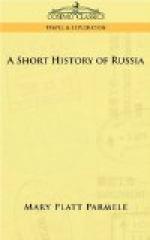An extraordinary thing had happened. A nameless adventurer and impostor had been received with tears of joy as the son of Ivan and of St. Vladimir, the seventh wife of Ivan the Terrible even recognizing and embracing him as her son! But Dmitri had not the wisdom to keep what his cunning had won. His Polish wife came, followed by a suite of Polish Catholics, who began to carry things with a high hand. The clergy was offended and soon enraged. In five years Dmitri was assassinated, and his mutilated corpse was lying in the palace at the Kremlin, an object of insult and derision; and then, for Russia there came another chaos.
For a brief period Vasili Shuiski, head of one of the princely families, reigned, while two more “false Dmitris” appeared, one from Sweden and the other from Poland. The cause of the latter was upheld by the King of Poland, with the ulterior purpose of bringing the disordered state of Russia under the Polish crown, and making one great Slav kingdom with its center at Cracow.
So disorganized had the State become that some of the Princes had actually opened negotiations with Sigismund with a view to offering the crown to his son. But when Sigismund with an invading army was in Moscow (1610), and when Vasili Shuiski was a prisoner in Poland, and a Polish Prince was claiming the title of Tsar, there came an awakening—not among the nobility, but deep down in the heart of orthodox Russia. From this awakening of a dormant national sentiment and of the religious instincts of the people there developed that event,—the most health-restoring which can come to the life of a nation,—a national uprising in which all classes unite in averting a common disaster. What disaster could be for Russia more terrible than an absorption into Catholic Poland? The Polish intruders and pretenders were driven out, and then a great National Assembly gathered at Moscow (1613) to elect a Tsar.
The name of Romanoff was unstained by crime, and was by maternal ancestry allied to the royal race of Rurik. The newly awakened patriotism turned instinctively toward that, as the highest expression of their hopes; and Mikhail Romanoff, a youth of 16, was elected Tsar.
It was in 1547 that Anastasia, of the House of Romanoff, had married Ivan IV. At about the same time her brother was married to a Princess of Suzdal, a descendant of the brother of Alexander Nevski. This Princess was the grandmother of Mikhail Romanoff, and the source from which has sprung the present ruling house in Russia.
CHAPTER XIII
NIKON’S ATTEMPT—RASKOLNIKS
In the building of an empire there are two processes—the building up, and the tearing down. The plow is no less essential than the trowel. The period after Boris had been for Russia the period of the wholesome plow. The harvest was far off. But the name Romanoff was going to stand for another Russia, not like the old Russia of Kief, nor yet the new Russia of Moscow; but another and a Europeanized Russia, in which, after long struggles, the Slavonic and half-Asiatic giant was going to tear down the walls of separation, escape from his barbarism, and compel Europe to share with him her civilization.




